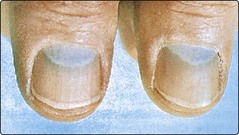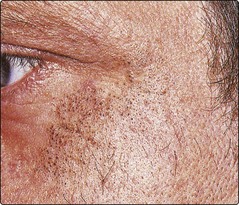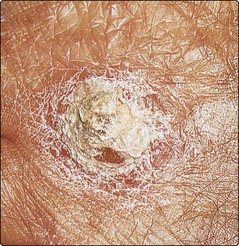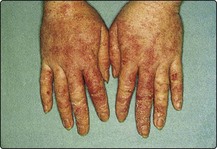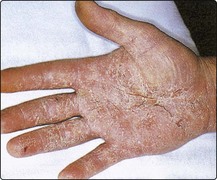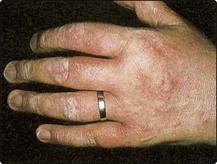Occupation and the skin
Skin disorders, after stress and musculoskeletal problems, are the commonest reported cause of occupational disease and are responsible for much lost productivity. An occupational dermatosis is defined as a skin condition that is primarily due to components of the work environment and would not have occurred unless the individual were doing that job.
Diagnosis
Proving a work association can be difficult. The following give clues:
 Contact with a known noxious agent.
Contact with a known noxious agent.
 Similar skin disease in other workers.
Similar skin disease in other workers.
 Consistent exposure-to-onset time course.
Consistent exposure-to-onset time course.
 Attacks appear with exposure, improve on withdrawal.
Attacks appear with exposure, improve on withdrawal.
Contact dermatitis is the most common work-related skin disease and is more often irritant than allergic. Contact urticaria, particularly to latex, is now well recognized. Other occupational dermatoses are listed in Table 1. Certain infections, e.g. anthrax (p. 50), orf (p. 52) and tinea corporis (p. 58) may be occupational. Heat, cold, ultraviolet radiation, vibration and X-rays can cause industrial disease.
Table 1 Rarer occupational skin disorders
| Condition | Presentation | Occupational exposure |
|---|---|---|
| Argyria (Fig. 1) | Slate-grey pigmentation on face, hands, sclerae | Industrial processes, e.g. silver smelters |
| Chloracne (Fig. 2) | Multiple open and closed comedones on cheeks and behind ears | Halogenated aromatic hydrocarbons, e.g. contamination during manufacture |
| Occupational vitiligo (p. 74) | Symmetrical pigment loss on face and hands | Substituted phenols or catechols in oils, at coking plant |
| Tar keratoses (Fig. 3) | Small keratotic warts on face and hand, premalignant | Tar and pitch, e.g. road work or coking plant; UV is a co-carcinogen |
| Vibration white finger | Blanching and pain in digits, later swelling and impaired fine movement | Hand-held vibrating tools, as used by rock drillers or chainsaw operators |
Contact dermatitis
It is often difficult to differentiate between allergic and irritant causes.
Aetiopathogenesis
Many industrial substances are irritants and some are allergens as well (p. 34). Water, detergents, alkalis, coolant oils and solvents are important irritants. Common allergens include chromate, rubber chemicals, preservatives, nickel, fragrances, epoxy resins and phenol-formaldehyde resins (Table 2).
Table 2 Contact dermatitis hazards in selected occupations
| Occupation | Irritants | Allergens |
|---|---|---|
| Bakers | Flour, detergent, sugar, enzymes | Flavouring, oil, antioxidant |
| Building trade workers | Cement, glass wool, acid, preservatives | Cement (Cr, Co), rubber, resin, wood |
| Caterers, cooks | Meat, fish, fruit, vegetables, detergent, water | Vegetables/fruit, cutlery (Ni), rubber gloves, spice |
| Cleaners | Detergent, solvent, water, friction | Rubber gloves, nickel, fragrance |
| Dental personnel | Detergent, soap, acrylate, flux | Rubber, acrylate, fragrance, mercury |
| Electronics assemblers | Solder, solvent, fibreglass, acid | Cr, Co, Ni, acrylate, epoxy resin |
| Hairdressers | Shampoo, bleach, perm lotion, soap, water, friction | Para-phenylenediamine dye, rubber, fragrance, thioglycolate |
| Metal workers | Cutting fluid, cleanser, solvent | Preservative, Ni, Cr, Co, antioxidant |
| Office workers | Paper, fibreglass, dry atmosphere | Rubber, Ni, dye, glue, copying paper |
| Textile workers | Solvent, bleach, fibre, formaldehyde | Formaldehyde resin, dye, Ni |
| Veterinarians, farmers | Disinfectant, animal secretion | Rubber, antibiotics, plants, preservative |
Irritant dermatitis frequently results from cumulative exposure to multiple types of irritant. An irritant dermatitis increases epidermal penetration by allergens and, because of this, it predisposes to superimposed contact sensitization. Similarly, allergic contact dermatitis renders skin vulnerable to attack by irritants.
Constitutional factors, especially atopic eczema, predispose to contact dermatitis. Environmental factors such as physical friction, occlusion, heat, cold, dry air from air conditioning or sudden swings in air temperature or humidity also have an effect.
Clinical presentation
The hands are affected, alone or with other sites, in 80–90% of occupational cases. The arms can be involved if not covered, and the face and neck are affected if there is exposure to dust or fumes. Cement workers often have lower leg and foot dermatitis in addition to hand changes. Allergy to rubber chemicals can cause dermatitis from rubber gloves or boots. Some workers develop ‘hardening’, an adaptive tolerance to irritants or allergies.
Occupational dermatitis appears at any age, but peaks at each end of working life. In bakers and hairdressers, dermatitis appears early. In cement workers, chromate dermatitis requires a few years to develop. Cumulative irritant dermatitis appears after several years’ exposure.
Case history 1
Hand dermatitis
A 17-year-old girl who had had childhood atopic eczema started as a hairdressing apprentice. Within 8 weeks, she developed hand dermatitis (Fig. 4) unresponsive to emollients and topical steroids. Patch testing was positive for ammonium thioglycolate (a permanent wave agent) and nickel. A diagnosis was made of contact dermatitis with irritant and allergic components, in an individual with underlying endogenous eczema. Her dermatitis cleared within weeks when she left hairdressing to work in an office.
Differential diagnosis
Contact dermatitis due to non-occupational exposure and endogenous eczemas need considering. Often, occupational dermatitis is multifactorial, with irritants, allergens, endogenous factors and secondary bacterial infection all causally involved.
Management
Patch testing (p. 126) is required if there is exposure to known allergens. A factory visit helps to ascertain the exact nature of irritant or allergen exposure.
Once recognized, occupational exposure to a causative agent can be minimized, but this does not always produce an improvement. Chromate allergy is particularly intransigent. Any dermatitis is treated along standard lines with special attention to hand care. Barrier creams are of dubious value.
Contact urticaria
Some proteins and chemicals provoke immediate urticaria (p. 108). The release of mast cell histamine or other mediators may or may not be immunoglobulin (Ig) E mediated. Pruritus, erythema and whealing appear within minutes and last a few hours.
Occupational contacts include latex in rubber gloves, foods (e.g. fish, potato, eggs, flour, spices, meats and numerous fruits), Myroxylon pereirae (a perfume and flavouring agent) and animal saliva. Contact dermatitis may coexist.
Latex contact urticaria has been a problem in healthcare workers and other occupations. Anaphylaxis may occur if there is a massive latex exposure, e.g. in a patient exposed to surgeon’s gloves during abdominal surgery.
Case history 2
Chromate dermatitis
A 30-year-old man had been employed for 3 years making pipes out of cement. This involved exposure to wet cement. Despite wearing gloves and overalls, he developed dermatitis on the hands (Fig. 5), arms and lower legs. Patch testing showed chromate allergy. He received compensation for having an industrial disease but, even when he changed his occupation to driving, he continued to have hand dermatitis.
Case history 3
Contact urticaria
A 40-year-old female nurse gave a 12-month history of itching, swelling and redness on her hands (Fig. 6), which developed within minutes of wearing disposable latex gloves. Patch testing was negative, but a prick test was positive for latex (confirmed by specific IgE test). Her symptoms resolved when she changed to nitrile gloves. Provision of latex-free disposable gloves to healthcare workers seems to have reduced the prevalence of latex allergy.
Prevention
Reducing the contact time between the skin and noxious substances is the aim. It is achieved by:
 improved work practices, e.g. increased automation
improved work practices, e.g. increased automation
 substituting an alternative, e.g. nitrile gloves instead of latex rubber
substituting an alternative, e.g. nitrile gloves instead of latex rubber
Recognizing an occupational disease may highlight faulty work practices that can be corrected. Compensation may be due.
Occupation and the skin
 Occurrence: industrial skin disease is common, especially contact dermatitis.
Occurrence: industrial skin disease is common, especially contact dermatitis.
 Causation: occupational contact dermatitis is caused more by irritants than by allergens but is often multifactorial, with endogenous factors frequently being involved in addition.
Causation: occupational contact dermatitis is caused more by irritants than by allergens but is often multifactorial, with endogenous factors frequently being involved in addition.
 Predisposition: previous atopic eczema predisposes to occupational contact dermatitis.
Predisposition: previous atopic eczema predisposes to occupational contact dermatitis.
 Patch testing: can help identify an allergen, e.g. chromate or rubber chemicals.
Patch testing: can help identify an allergen, e.g. chromate or rubber chemicals.
 Contact urticaria to latex has been a risk in healthcare workers and other occupations, but appears less so now.
Contact urticaria to latex has been a risk in healthcare workers and other occupations, but appears less so now.
 Prevention: occupational skin disease is minimized by reducing the contact time of noxious agents with the skin and by increasing awareness of the problem.
Prevention: occupational skin disease is minimized by reducing the contact time of noxious agents with the skin and by increasing awareness of the problem.
